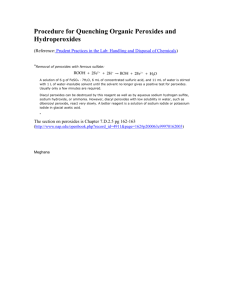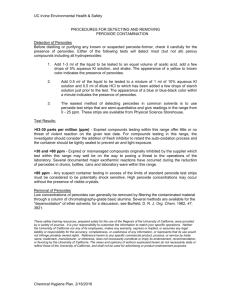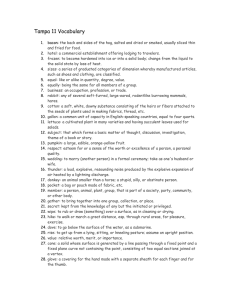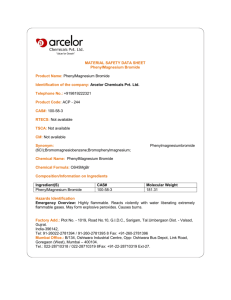P21 - Working with Highly Reactive or Explosive Chemicals
advertisement
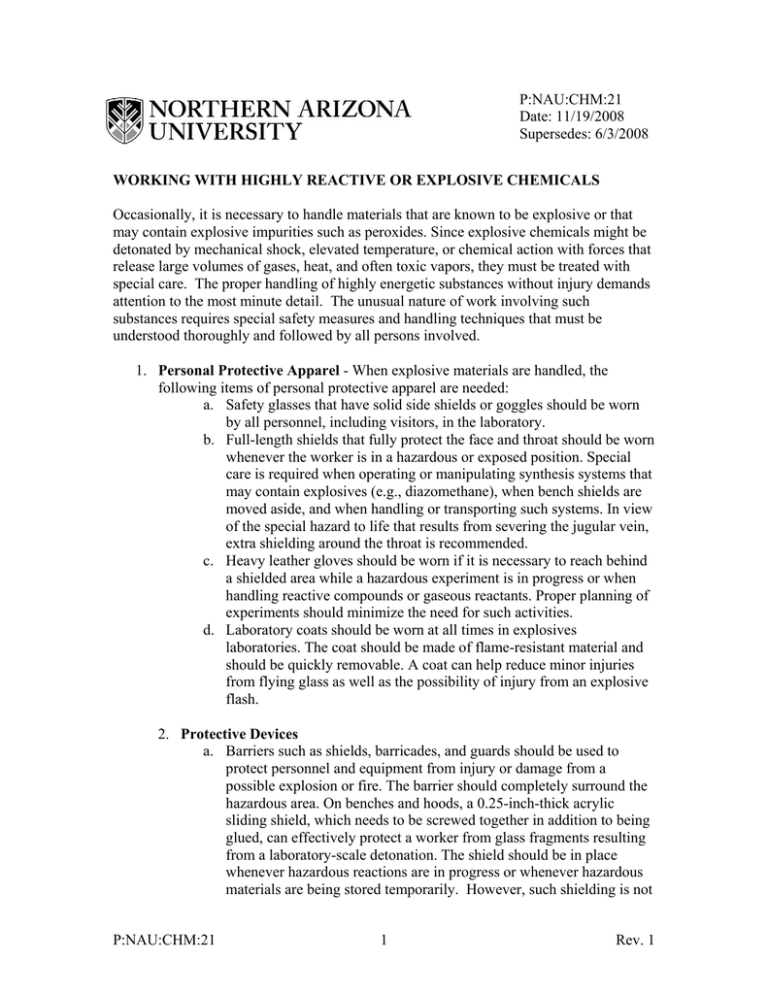
P:NAU:CHM:21 Date: 11/19/2008 Supersedes: 6/3/2008 WORKING WITH HIGHLY REACTIVE OR EXPLOSIVE CHEMICALS Occasionally, it is necessary to handle materials that are known to be explosive or that may contain explosive impurities such as peroxides. Since explosive chemicals might be detonated by mechanical shock, elevated temperature, or chemical action with forces that release large volumes of gases, heat, and often toxic vapors, they must be treated with special care. The proper handling of highly energetic substances without injury demands attention to the most minute detail. The unusual nature of work involving such substances requires special safety measures and handling techniques that must be understood thoroughly and followed by all persons involved. 1. Personal Protective Apparel - When explosive materials are handled, the following items of personal protective apparel are needed: a. Safety glasses that have solid side shields or goggles should be worn by all personnel, including visitors, in the laboratory. b. Full-length shields that fully protect the face and throat should be worn whenever the worker is in a hazardous or exposed position. Special care is required when operating or manipulating synthesis systems that may contain explosives (e.g., diazomethane), when bench shields are moved aside, and when handling or transporting such systems. In view of the special hazard to life that results from severing the jugular vein, extra shielding around the throat is recommended. c. Heavy leather gloves should be worn if it is necessary to reach behind a shielded area while a hazardous experiment is in progress or when handling reactive compounds or gaseous reactants. Proper planning of experiments should minimize the need for such activities. d. Laboratory coats should be worn at all times in explosives laboratories. The coat should be made of flame-resistant material and should be quickly removable. A coat can help reduce minor injuries from flying glass as well as the possibility of injury from an explosive flash. 2. Protective Devices a. Barriers such as shields, barricades, and guards should be used to protect personnel and equipment from injury or damage from a possible explosion or fire. The barrier should completely surround the hazardous area. On benches and hoods, a 0.25-inch-thick acrylic sliding shield, which needs to be screwed together in addition to being glued, can effectively protect a worker from glass fragments resulting from a laboratory-scale detonation. The shield should be in place whenever hazardous reactions are in progress or whenever hazardous materials are being stored temporarily. However, such shielding is not P:NAU:CHM:21 1 Rev. 1 effective against metal shrapnel. The laboratory hood sash provides a safety shield only against chemical splashes or sprays, fires, and minor explosions. If more than one hazardous reaction is carried out, the reactions should be shielded from each other and separated as far as possible. b. Miscellaneous protective devices such as both long-and short-handled tongs for holding or manipulating hazardous items at a safe distance and remote control equipment (e.g., mechanical arms, stopcock turners, labjack turners, remote cable controllers, and closed-circuit television monitors) should be available as required to prevent exposure of any part of the body to injury. 3. Evaluating Potentially Reactive Materials a. Potentially reactive materials must be evaluated for their possible explosive characteristics by consulting the literature and considering their molecular structures. Highly reactive chemicals should be segregated from materials that might interact with them to create a risk of explosion. Highly reactive chemicals should not be used past their expiration date. 4. Organic Peroxides a. Organic peroxides are a special class of compounds whose unusually low stability makes them among the most hazardous substances commonly handled in laboratories, especially as initiators for freeradical reactions. Although they are low-power explosives, they are hazardous because of their extreme sensitivity to shock, sparks, and other forms of accidental detonation. Many peroxides that are handled routinely in laboratories are far more sensitive to shock than most primary explosives (e.g., TNT), although many have been stabilized by the addition of compounds that inhibit reaction. Nevertheless, even low rates of decomposition may automatically accelerate and cause a violent explosion, especially in bulk quantities of peroxides (e.g., benzoyl peroxide). These compounds are sensitive to heat, friction, impact, and light, as well as to strong oxidizing and reducing agents. All organic peroxides are highly flammable, and fires involving bulk quantities of peroxides should be approached with extreme caution. b. Precautions for handling peroxides include the following: i. Limit the quantity of peroxide to the minimum amount required. Do not return unused peroxides to the container. ii. Clean up all spills immediately. Solutions of peroxides can be absorbed on vermiculite or other absorbing material and disposed of harmlessly according to institutional procedures. iii. The sensitivity of most peroxides to shock and heat can be reduced by dilution with inert solvents, such as aliphatic hydrocarbons. However, do not use aromatics (such as P:NAU:CHM:21 2 Rev. 1 iv. v. vi. vii. viii. ix. toluene), which are known to induce the decomposition of diacyl peroxides. Do not use solutions of peroxides in volatile solvents under conditions in which the solvent might be vaporized because this will increase the peroxide concentration in the solution. Do not use metal spatulas to handle peroxides because contamination by metals can lead to explosive decomposition. Magnetic stirring bars can unintentionally introduce iron, which can initiate an explosive reaction of peroxides. Ceramic, Teflon, or wooden spatulas and stirring blades may be used if it is known that the material is not shock-sensitive. Do not permit smoking, open flames, and other sources of heat near peroxides. It is important to label areas that contain peroxides so that this hazard is evident. Avoid friction, grinding, and all forms of impact near peroxides, especially solid peroxides. Glass containers that have screw-cap lids or glass stoppers should not be used. Polyethylene bottles that have screw-cap lids may be used. To minimize the rate of decomposition, store peroxides at the lowest possible temperature consistent with their solubility or freezing point. Do not store liquid peroxides or solutions at or lower than the temperature at which the peroxide freezes or precipitates because peroxides in these forms are extremely sensitive to shock and heat. If a container of peroxide-forming material is past its expiration date, contact NAU’s Office of Regulatory Compliance for disposal. 5. Disposal of Peroxides a. Pure peroxides should never be disposed of directly but must be diluted before disposal. Small quantities (25 g or less) of peroxides are generally disposed of by dilution with water to a concentration of 2% or less, after which the solution is transferred to a polyethylene bottle containing an aqueous solution of a reducing agent, such as ferrous sulfate or sodium bisulfite. The material can then be handled as a waste chemical; however, it must not be mixed with other chemicals for disposal. b. Spilled peroxides should be absorbed on vermiculite or other absorbent as quickly as possible. Organic peroxides should never be flushed down the drain. Large quantities (more than 25 g) of peroxides require special handling. Each case should be considered separately, and handling, storage, and disposal procedures should be determined by the physical and chemical properties of the particular peroxide. c. Peroxides can be formed during storage of some materials in air, and a peroxide present as a contaminant in a reagent or solvent (e.g., 1,4- P:NAU:CHM:21 3 Rev. 1 d. e. f. g. dioxane) can be very hazardous and change the course of a planned reaction. Especially dangerous are ether bottles that have evaporated to dryness. Excluding oxygen by storing potential peroxide-formers under an inert atmosphere (N2 or argon) or under vacuum greatly increases their safe storage lifetime. In many instances, it is possible to purchase the chemical stored under nitrogen in septum-capped bottles. In some cases, stabilizers or inhibitors (free-radical scavengers that terminate the chain reaction) are added to the liquid to extend its storage lifetime. Because distillation of the stabilized liquid removes the stabilizer, the distillate must be stored with care and monitored for peroxide formation. HPLC-grade solvents generally contain no stabilizer, and the same considerations apply to their handling. 6. Explosive Gases and Liquefied Gases a. A substance is more concentrated in the form of a liquefied gas than in the vapor phase and may evaporate extremely rapidly. Contact with liquid oxygen, in particular, may introduce extreme risk. Liquefied air is almost as dangerous as liquid oxygen because the nitrogen boils away, and as it does, it leaves an increasing concentration of oxygen. Other cryogenic liquids, such as nitrogen and helium, if they have been open to air, may have absorbed and condensed enough atmospheric oxygen to be very hazardous. b. When a liquefied gas is used in a closed system, pressure may build up, so that adequate venting is required. Relief devices are required to prevent this dangerous buildup of pressure. If the liquid is flammable (e.g., hydrogen), explosive concentrations in air may develop. Because flammability, toxicity, and pressure buildup may become serious when gases are exposed to heat, gases should be stored only in specifically designed and designated areas. 7. Hydrogenation Reactions a. Hydrogenation reactions are often carried out under pressure with a reactive catalyst and so require special attention. Along with observation of the precautions for the handling of gas cylinders and flammable gases, additional attention must be given to carrying out hydrogenation reactions at pressures above 1 atm. The following precautions are applicable: b. Make sure that the autoclave, pressure bottle, or other apparatus is appropriate for the experiment. Most preparative hydrogenations of substances such as alkenes can be carried out safely in a commercial hydrogenation apparatus using a heterogeneous catalyst (e.g., Pt and Pd) under moderate (<80 psi H2) pressure. c. Review the operating procedures for the apparatus, and inspect the container before each experiment. Glass reaction vessels are subject to P:NAU:CHM:21 4 Rev. 1 d. e. f. g. scratches or chips that render them unsuitable for use under pressure. Never fill the vessel to capacity with the solution; filling it about half full (or less) is much safer. One of the most important precautions to be taken with any reaction involving hydrogen is to remove as much oxygen from the solution as possible before adding hydrogen. Failure to do this could result in an explosive oxygen-hydrogen (O2/H2) mixture. Normally, the oxygen in the vessel is removed by pressurizing the vessel with inert gas (N2 or argon), followed by venting the gas. If available, vacuum can be applied to the solution. Repeat this procedure of filling with inert gas and venting several times before the hydrogen or other high-pressure gas is introduced. Do not approach the rated safe pressure limit of the bottle or autoclave, with due regard to increased pressure upon heating. A limit of 75% of the rating in a high-pressure autoclave is advisable, but if this limit is exceeded accidentally, replace the rupture disk upon completion of the experiment. Monitor the pressure of the high-pressure device periodically as the heating proceeds to avoid too high a pressure in case of unintentional overheating. Purge the system of hydrogen by repeated "rinsing" with inert gas at the end of the experiment to avoid producing hydrogen-oxygen mixtures in the presence of the catalyst during work-up. Handle catalyst that has been used in the reaction with special care because it can be a source of spontaneous ignition upon contact with air. 8. Reactive or Explosive Materials Requiring Special Attention - The following list is not intended to be all-inclusive. Further guidance on reactive and explosive materials should be sought from other sources of information a. Acetylenic compounds can be explosive in mixtures of 2.5 to 80% with air. At pressures of 2 or more atmospheres, acetylene (C2H2) subjected to an electrical discharge or high temperature decomposes with explosive violence. Dry acetylides detonate on receiving the slightest shock. Acetylene must be handled in acetone solution and never stored alone in a cylinder. b. Aluminum chloride (AlCl3) should be considered a potentially dangerous material. If moisture is present, there may be sufficient decomposition to form hydrogen chloride (HC1) and build up considerable pressure. If a bottle is to be opened after long storage, it should first be completely enclosed in a heavy towel. c. Ammonia (NH3) reacts with iodine to give nitrogen triiodide, which detonates on touch. Ammonia reacts with hypochlorites to give chlorine. Mixtures of NH3 and organic halides sometimes react violently when heated under pressure. Ammonia is combustible. Inhalation of concentrated fumes can be fatal. P:NAU:CHM:21 5 Rev. 1 d. Azides, both organic and inorganic, and some azo compounds can be heat- and shock-sensitive. Azides such as sodium azide can displace halide from chlorinated hydrocarbons such as dichloromethane to form highly explosive organic polyazides; this substitution reaction is facilitated in solvents such as dimethyl sulfoxide (DMSO). e. Carbon disulfide (CS2) is both very toxic and very flammable; mixed with air, its vapors can be ignited by a steam bath or pipe, a hot plate, or a light bulb. f. Chlorine (C12) is toxic and may react violently with hydrogen (H2) or with hydrocarbons when exposed to sunlight. g. Chromium trioxide—pyridine complex (CrO3 C5H5N) may explode if the CrO3 concentration is too high. The complex should be prepared by addition of CrO3 to excess C5H5N. h. Diazomethane (CH2N2) and related diazo compounds should be treated with extreme caution. They are very toxic, and the pure gases and liquids explode readily even from contact with sharp edges of glass. Solutions in ether are safer from this standpoint. An ether solution of diazomethane is rendered harmless by drop wise addition of acetic acid. i. Diethyl, diisopropyl, and other ethers, including tetrahydrofuran and 1,4-dioxane and particularly the branched- chain type of ethers, sometimes explode during heating or refluxing because the presence of peroxides has developed from air oxidation. Ferrous salts or sodium bisulfite can be used to decompose these peroxides, and passage over basic active alumina can remove most of the peroxidic material. In general, however, old samples of ethers should be disposed of after testing, following procedures for disposal of peroxides. j. Dimethyl sulfoxide (DMSO), (CH3)2SO, decomposes violently on contact with a wide variety of active halogen compounds, such as acyl chlorides. Explosions from contact with active metal hydrides have been reported. Dimethyl sulfoxide does penetrate and carry dissolved substances through the skin membrane. k. Dry benzoyl peroxide (C6H5CO2)2 is easily ignited and sensitive to shock. It decomposes spontaneously at temperatures above 50 °C. It is reported to be desensitized by addition of 20% water. l. Dry ice should not be kept in a container that is not designed to withstand pressure. Containers of other substances stored over dry ice for extended periods generally absorb carbon dioxide (CO2) unless they have been sealed with care. When such containers are removed from storage and allowed to come rapidly to room temperature, the CO2 may develop sufficient pressure to burst the container with explosive violence. On removal of such containers from storage, the stopper should be loosened or the container itself should be wrapped in towels and kept behind a shield. Dry ice can produce serious burns, as is also true for all types of dry-ice-cooled cooling baths. P:NAU:CHM:21 6 Rev. 1 m. Drying agents, such as Ascarite® (sodium hydroxide-coated silica), should not be mixed with phosphorus pentoxide (P2O5) because the mixture may explode if it is warmed with a trace of water. Because the cobalt salts used as moisture indicators in some drying agents may be extracted by some organic solvents, the use of these drying agents should be restricted to drying gases. n. Dusts that are suspensions of oxidizable particles (e.g., magnesium powder, zinc dust, carbon powder, and flowers of sulfur) in the air can constitute powerful explosive mixtures. These materials should be used with adequate ventilation and should not be exposed to ignition sources. When finely divided, some solids, including zirconium, titanium, Raney nickel, lead (such as prepared by pyrolysis of lead tartrate), and catalysts (such as activated carbon containing active metals and hydrogen), can combust spontaneously if allowed to dry while exposed to air and should be handled wet. o. Ethylene oxide (C2H4O) has been known to explode when heated in a closed vessel. Experiments using ethylene oxide under pressure should be carried out behind suitable barricades. p. Halogenated compounds, such as chloroform (CHCl3), carbon tetrachloride (CC14), and other halogenated solvents, should not be dried with sodium, potassium, or other active metal; violent explosions usually result. Many halogenated compounds are toxic. Oxidized halogen compounds—chlorates, chlorites, bromates, and iodates—and the corresponding peroxy compounds may be explosive at high temperatures. q. Hydrogen peroxide (H2O2) stronger than 3% can be dangerous; in contact with the skin, it can cause severe burns. Thirty percent H2O2 may decompose violently if contaminated with iron, copper, chromium, or other metals or their salts. Stirring bars may inadvertently bring metal into a reaction and should be used with caution. r. Liquid nitrogen-cooled traps open to the atmosphere condense liquid air rapidly. Then, when the coolant is removed, an explosive pressure buildup occurs, usually with enough force to shatter glass equipment if the system has been closed. Hence, only sealed or evacuated equipment should be so cooled. s. Lithium aluminum hydride (LiAlH4) should not be used to dry methyl ethers or tetrahydrofuran; fires from reaction with damp ethers are often observed. The reaction of LiAlH4 with carbon dioxide has reportedly generated explosive products. Carbon dioxide or bicarbonate extinguishers should not be used for LiAlH4 fires; instead such fires should be smothered with sand or some other inert substance. t. Nitrates, nitro and nitroso compounds may be explosive, especially if more than one nitro group is present. Alcohols and polyols can form P:NAU:CHM:21 7 Rev. 1 u. v. w. x. y. z. P:NAU:CHM:21 highly explosive nitrate esters (e.g., nitroglycerine) from reaction with nitric acid. Organometallics are hazardous because some organometallic compounds burn vigorously on contact with air or moisture. For example, solutions of t-butyl lithium can cause ignition of some organic solvents on exposure to air. The pertinent information should be obtained for a specific compound. Oxygen tanks should be handled with care because serious explosions have resulted from contact between oil and high-pressure oxygen. Oil or grease should not be used on connections to an O2 cylinder or gas line carrying O2. Ozone (O3) is a highly reactive and toxic gas. It is formed by the action of ultraviolet light on oxygen (air), and, therefore, certain ultraviolet sources may require venting to the exhaust hood. Ozonides can be explosive. Palladium (Pd) or platinum (Pt) on carbon, platinum oxide, Raney nickel, and other catalysts present the danger of explosion if additional catalyst is added to a flask in which an air-flammable vapor mixture and/ or hydrogen is present. The use of flammable filter paper should be avoided. Parr bombs used for hydrogenations should be handled with care behind a shield, and the operator should wear goggles and a face shield. Perchlorates should be avoided insofar as possible. Perchlorate salts of organic, organometallic, and inorganic cations are potentially explosive and have been set off either by heating or by shock. Perchlorates should not be used as drying agents if there is a possibility of contact with organic compounds or of proximity to a dehydrating acid strong enough to concentrate the perchloric acid (HClO4) (e.g., in a drying train that has a bubble counter containing sulfuric acid). Safer drying agents should be used. Seventy percent HClO4 can be boiled safely at approximately 200 °C, but contact of the boiling undiluted acid or the hot vapor with organic matter, or even easily oxidized inorganic matter, will lead to serious explosions. Oxidizable substances must never be allowed to contact HClO4. This includes wooden benchtops or hood enclosures, which may become highly flammable after absorbing HClO4 liquid or vapors. Beaker tongs, rather than rubber gloves, should be used when handling fuming HClO4. Perchloric acid evaporations should be carried out in a hood that has a good draft. The hood and ventilator ducts should be washed with water frequently (weekly; but see also section 8.C.7.5) to avoid danger of spontaneous combustion or explosion if this acid is in common use. Special perchloric acid hoods are available from many manufacturers. Disassembly of such hoods must be preceded by washing of the ventilation system to remove deposited perchlorates. 8 Rev. 1 aa. Permanganates are explosive when treated with sulfuric acid. If both compounds are used in an absorption train, an empty trap should be placed between them and monitored for entrapment. bb. Peroxides (inorganic) should be handled carefully. When mixed with combustible materials, barium, sodium, and potassium peroxides form explosives that ignite easily. cc. Phosphorus (P) (red and white) forms explosive mixtures with oxidizing agents. White phosphorus should be stored under water because it ignites spontaneously in air. The reaction of phosphorus with aqueous hydroxides gives phosphine, which may either ignite spontaneously or explode in air. dd. Phosphorus trichloride (PC13) reacts with water to form phosphorous acid with HCl evolution; the phosphorous acid decomposes on heating to form phosphine, which may either ignite spontaneously or explode. Care should be taken in opening containers of PCl3, and samples that have been exposed to moisture should not be heated without adequate shielding to protect the operator. ee. Potassium (K) is much more reactive than sodium; it ignites quickly on exposure to humid air and, therefore, should be handled under the surface of a hydrocarbon solvent such as mineral oil or toluene (see Sodium). Potassium can form explosive peroxides on contact with air. If this happens, the act of cutting a surface crust off the metal can cause a severe explosion. ff. Residues from vacuum distillations have been known to explode when the still was vented suddenly to the air before the residue was cool. Such explosions can be avoided by venting the still pot with nitrogen, by cooling it before venting, or by restoring the pressure slowly. Sudden venting may produce a shockwave that can detonate sensitive materials. gg. Sodium (Na) should be stored in a closed container under kerosene, toluene, or mineral oil. Scraps of sodium or potassium should be destroyed by reaction with n-butyl alcohol. Contact with water should be avoided because sodium reacts violently with water to form hydrogen (H2) with evolution of sufficient heat to cause ignition. Carbon dioxide, bicarbonate, and carbon tetrachloride fire extinguishers should not be used on alkali metal fires. Metals like sodium become more reactive as the surface area of the particles increases. Prudence dictates using the largest particle size consistent with the task at hand. For example, use of sodium ''balls" or cubes is preferable to use of sodium "sand" for drying solvents. hh. Sodium amide (NaNH2) can undergo oxidation on exposure to air to give sodium nitrite in a mixture that is unstable and may explode. ii. Sulfuric acid (H2SO4) should be avoided, if possible, as a drying agent in desiccators. If it must be used, glass beads should be placed in it to help prevent splashing when the desiccator is moved. To dilute H2SO4, the acid should be added slowly to cold water. Addition of P:NAU:CHM:21 9 Rev. 1 water to the denser H2SO4 can cause localized surface boiling and spattering on the operator. jj. Trichloroethylene (Cl2CCHCl) reacts under a variety of conditions with potassium or sodium hydroxide to form dichloroacetylene, which ignites spontaneously in air and detonates readily even at dry ice temperatures. The compound itself is highly toxic, and suitable precautions should be taken when it is used. P:NAU:CHM:21 10 Rev. 1
